最新人教版七年级英语上册教案全册
人教版英语七上教案7篇
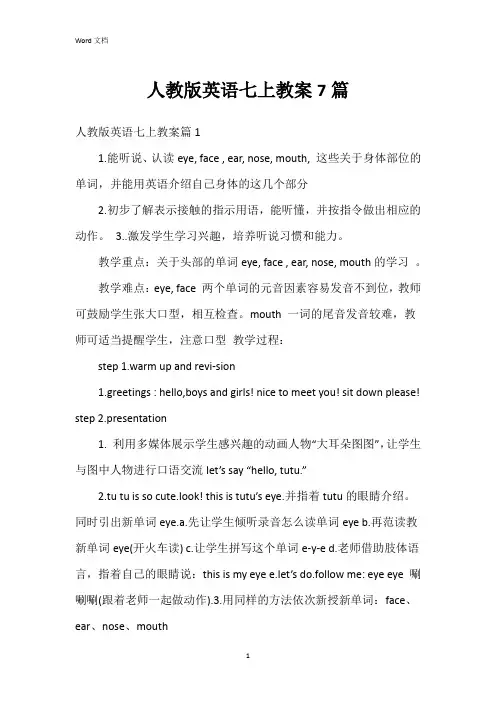
人教版英语七上教案7篇人教版英语七上教案篇11.能听说、认读eye, face , ear, nose, mouth, 这些关于身体部位的单词,并能用英语介绍自己身体的这几个部分2.初步了解表示接触的指示用语,能听懂,并按指令做出相应的动作。
3..激发学生学习兴趣,培养听说习惯和能力。
教学重点:关于头部的单词eye, face , ear, nose, mouth的学习。
教学难点:eye, face 两个单词的元音因素容易发音不到位,教师可鼓励学生张大口型,相互检查。
mouth 一词的尾音发音较难,教师可适当提醒学生,注意口型教学过程:step 1.warm up and revi-sion1.greetings : hello,boys and girls! nice to meet you! sit down please! step2.presentation1. 利用多媒体展示学生感兴趣的动画人物“大耳朵图图”,让学生与图中人物进行口语交流let’s say “hello, tutu.”2.tu tu is so cute.look! this is tutu’s eye.并指着tutu的眼睛介绍。
同时引出新单词eye.a.先让学生倾听录音怎么读单词eye b.再范读教新单词eye(开火车读) c.让学生拼写这个单词e-y-e d.老师借助肢体语言,指着自己的眼睛说:this is my eye e.let’s do.follow me: eye eye 唰唰唰(跟着老师一起做动作).3.用同样的方法依次新授新单词:face、ear、nose、mouth4.powerpoint制作:打开幻灯片后每点击一身体部位就会出现相应的单词。
(注mouth一词的尾音发音较难,适当提醒学生,注意口型。
)5.认读face、ear、eye、nose、mouth的单词卡片和图片。
step3:practice1.let’s do: eye eye 唰唰唰ear ear 呼呼呼nose nose 闻闻闻mouth mouth 巴巴巴face face 拍拍拍2.i say you do.(老师说,学生快速做相应的动作,然后找一位学生出来做出动作。
2024-2024年学年秋季学期人教版pep初中七年级英语上册教案全册
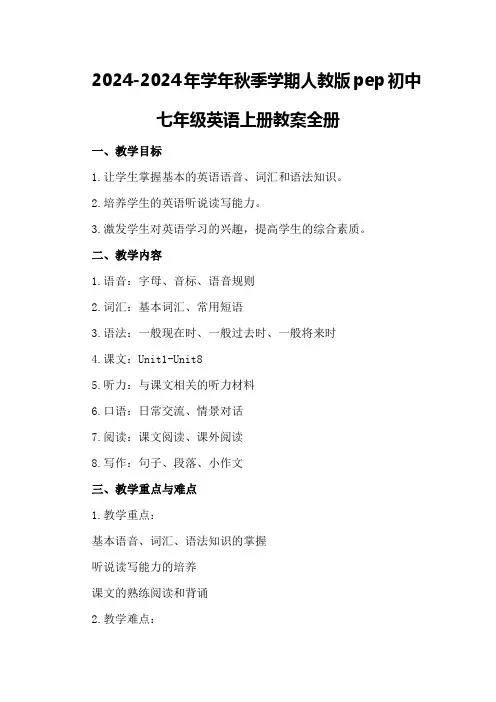
2024-2024年学年秋季学期人教版pep初中七年级英语上册教案全册一、教学目标1.让学生掌握基本的英语语音、词汇和语法知识。
2.培养学生的英语听说读写能力。
3.激发学生对英语学习的兴趣,提高学生的综合素质。
二、教学内容1.语音:字母、音标、语音规则2.词汇:基本词汇、常用短语3.语法:一般现在时、一般过去时、一般将来时4.课文:Unit1-Unit85.听力:与课文相关的听力材料6.口语:日常交流、情景对话7.阅读:课文阅读、课外阅读8.写作:句子、段落、小作文三、教学重点与难点1.教学重点:基本语音、词汇、语法知识的掌握听说读写能力的培养课文的熟练阅读和背诵2.教学难点:音标发音的准确性语法规则的灵活运用课外阅读的理解与分析四、教学进度安排1.第一周:Unit11.1Greetingsandintroductions 1.2Numbersandages1.3Colors2.第二周:Unit22.1Schoolsubjects2.2Classroomobjects2.3Dlyroutines3.第三周:Unit33.1Foodanddrink3.2Describingfood3.3Makingrequests4.第四周:Unit44.1Familymembers4.2Describingpeople4.3Talkingaboutfamily5.第五周:Unit55.1Time5.2Daysoftheweek5.3Activities6.第六周:Unit66.1Weather6.2Clothing6.3Describingtheweather7.第七周:Unit77.1Inthelibrary7.2Intheclassroom7.3Inthesupermarket8.第八周:Unit88.1Sports8.2Describingsports8.3Talkingaboutsports五、教学方法1.采用任务型教学法,让学生在实际语境中学习英语。
2023年人教版七年级上册英语全册教案
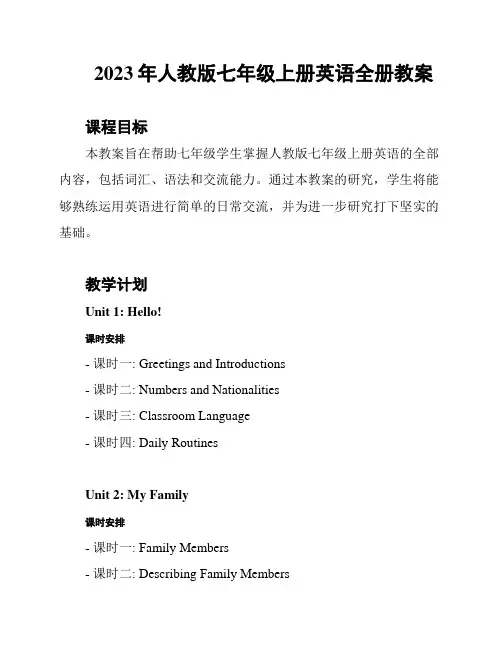
2023年人教版七年级上册英语全册教案课程目标本教案旨在帮助七年级学生掌握人教版七年级上册英语的全部内容,包括词汇、语法和交流能力。
通过本教案的研究,学生将能够熟练运用英语进行简单的日常交流,并为进一步研究打下坚实的基础。
教学计划Unit 1: Hello!课时安排- 课时一: Greetings and Introductions- 课时二: Numbers and Nationalities- 课时三: Classroom Language- 课时四: Daily RoutinesUnit 2: My Family课时安排- 课时一: Family Members- 课时二: Describing Family Members- 课时三: Family Activities- 课时四: Talking about HobbiesUnit 3: School Life课时安排- 课时一: School Facilities- 课时二: Class Schedule- 课时三: Extracurricular Activities- 课时四: Talking about FavoritesUnit 4: Food and Drinks课时安排- 课时一: Food and Drinks Vocabulary- 课时二: Ordering Food and Drinks- 课时三: Talking about Preferences- 课时四: Inviting and Accepting/DecliningUnit 5: My Day课时安排- 课时一: Daily Routine Vocabulary- 课时二: Telling Time- 课时三: Describing Leisure Activities- 课时四: Making PlansUnit 6: My Home课时安排- 课时一: Rooms and Furniture- 课时二: Describing Rooms- 课时三: Giving Directions- 课时四: Talking about ChoresUnit 7: Festivals and Celebrations课时安排- 课时一: Festivals and Celebrations Vocabulary - 课时二: Talking about Traditions- 课时三: Invitations and Excuses- 课时四: Giving Gifts and Thanks教学方法为了达到教学目标,本课程将采用多种教学方法,包括但不限于:- 听力练: 听录音,理解并回答问题,提高听力能力;- 口语练: 通过小组对话、角色扮演等活动,提高口语表达能力;- 书面练: 完成课后题,巩固所学知识;- 游戏和活动: 创设情境,进行游戏和活动,激发学生的研究兴趣。
七年级英语上册人教版全册教案
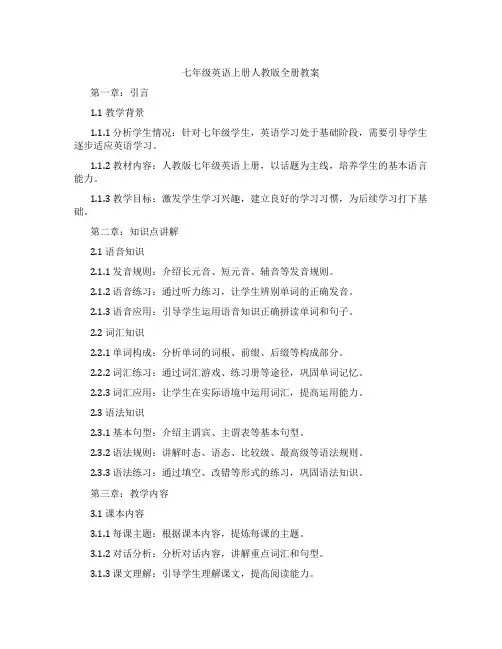
七年级英语上册人教版全册教案第一章:引言1.1 教学背景1.1.1 分析学生情况:针对七年级学生,英语学习处于基础阶段,需要引导学生逐步适应英语学习。
1.1.2 教材内容:人教版七年级英语上册,以话题为主线,培养学生的基本语言能力。
1.1.3 教学目标:激发学生学习兴趣,建立良好的学习习惯,为后续学习打下基础。
第二章:知识点讲解2.1 语音知识2.1.1 发音规则:介绍长元音、短元音、辅音等发音规则。
2.1.2 语音练习:通过听力练习,让学生辨别单词的正确发音。
2.1.3 语音应用:引导学生运用语音知识正确拼读单词和句子。
2.2 词汇知识2.2.1 单词构成:分析单词的词根、前缀、后缀等构成部分。
2.2.2 词汇练习:通过词汇游戏、练习册等途径,巩固单词记忆。
2.2.3 词汇应用:让学生在实际语境中运用词汇,提高运用能力。
2.3 语法知识2.3.1 基本句型:介绍主谓宾、主谓表等基本句型。
2.3.2 语法规则:讲解时态、语态、比较级、最高级等语法规则。
2.3.3 语法练习:通过填空、改错等形式的练习,巩固语法知识。
第三章:教学内容3.1 课本内容3.1.1 每课主题:根据课本内容,提炼每课的主题。
3.1.2 对话分析:分析对话内容,讲解重点词汇和句型。
3.1.3 课文理解:引导学生理解课文,提高阅读能力。
3.2 拓展内容3.2.1 相关话题:针对课本内容,拓展相关话题。
3.2.2 听力练习:选择合适的听力材料,提高学生听力水平。
3.2.3 口语表达:组织口语交流活动,提高学生口语表达能力。
第四章:教学目标4.1 知识目标4.1.1 掌握基本的语音、词汇和语法知识。
4.1.2 能够听懂、说出一日常用语。
4.1.3 理解课本内容,具备一定的阅读和写作能力。
4.2 能力目标4.2.1 提高学生的听、说、读、写四项基本技能。
4.2.2 培养学生的语言运用能力和团队协作能力。
4.2.3 培养学生的跨文化交际意识。
七年级-人教版(2024新版)-英语-上册-【教学设计】-You-and-Me-(Period-1)
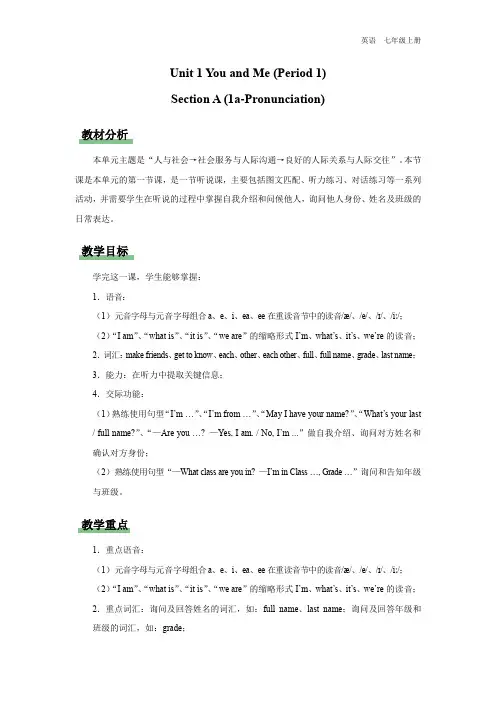
Unit 1 You and Me (Period 1)Section A (1a-Pronunciation)教材分析本单元主题是“人与社会→社会服务与人际沟通→良好的人际关系与人际交往”。
本节课是本单元的第一节课,是一节听说课,主要包括图文匹配、听力练习、对话练习等一系列活动,并需要学生在听说的过程中掌握自我介绍和问候他人,询问他人身份、姓名及班级的日常表达。
教学目标学完这一课,学生能够掌握:1.语音:(1)元音字母与元音字母组合a、e、i、ea、ee在重读音节中的读音/æ/、/e/、/ɪ/、/iː/;(2)“I am”、“what is”、“it is”、“we are”的缩略形式I’m、what’s、it’s、we’re的读音;2.词汇:make friends、get to know、each、other、each other、full、full name、grade、last name;3.能力:在听力中提取关键信息;4.交际功能:(1)熟练使用句型“I’m …”、“I’m from …”、“May I have your name?”、“What’s your last / full name?”、“—Are you …? —Yes, I am. / No, I’m ...”做自我介绍、询问对方姓名和确认对方身份;(2)熟练使用句型“—What class are you in? —I’m in Class …, Grade …”询问和告知年级与班级。
教学重点1.重点语音:(1)元音字母与元音字母组合a、e、i、ea、ee在重读音节中的读音/æ/、/e/、/ɪ/、/iː/;(2)“I am”、“what is”、“it is”、“we are”的缩略形式I’m、what’s、it’s、we’re的读音;2.重点词汇:询问及回答姓名的词汇,如:full name、last name;询问及回答年级和班级的词汇,如:grade;3.重点句型:询问及回答姓名的句型以及问候新朋友的句型。
人教课标版七年级上册英语全册教案
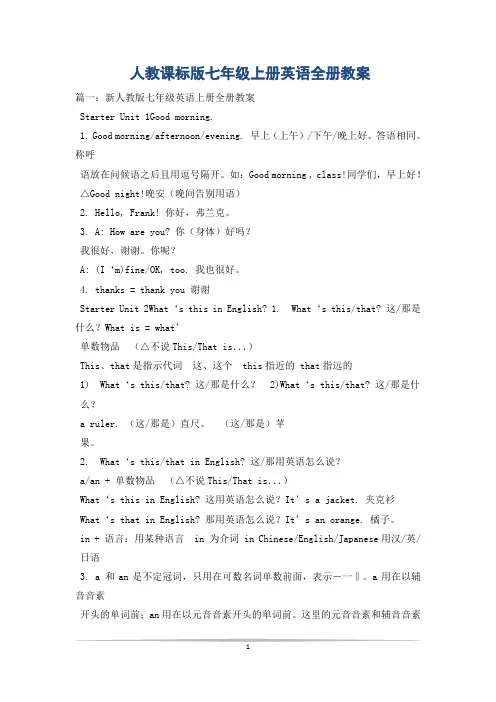
人教课标版七年级上册英语全册教案篇一:新人教版七年级英语上册全册教案Starter Unit 1Good morning.1. Good morning/afternoon/evening. 早上(上午)/下午/晚上好。
答语相同。
称呼语放在问候语之后且用逗号隔开。
如:Good morning , class!同学们,早上好!△Good night!晚安(晚间告别用语)2. Hello, Frank! 你好,弗兰克。
3. A: How are you? 你(身体)好吗?我很好,谢谢。
你呢?A: (I‘m)fine/OK, too. 我也很好。
4. thanks = thank you 谢谢Starter Unit 2What‘s this in English? 1. What‘s this/that? 这/那是什么?What is = what’单数物品(△不说This/That is...)This、that是指示代词这、这个 this指近的 that指远的1) What‘s this/that? 这/那是什么? 2)What‘s this/that? 这/那是什么?a ruler. (这/那是)直尺。
(这/那是)苹果。
2. What‘s this/that in English? 这/那用英语怎么说?a/an + 单数物品(△不说This/That is...)What‘s this in English? 这用英语怎么说?It’s a jacket. 夹克衫What‘s that in English? 那用英语怎么说?It’s an orange. 橘子。
in + 语言:用某种语言 in 为介词 in Chinese/English/Japanese用汉/英/ 日语3. a 和an是不定冠词,只用在可数名词单数前面,表示―一‖。
a用在以辅音音素开头的单词前;an用在以元音音素开头的单词前。
人教版初一英语上册教案15篇
人教版初一英语上册教案15篇人教版初一英语上册教案精选15篇教案可以帮助教师明确教学的目标和要求,指导教师在课堂上进行教学活动。
下面是小编为大家整理的人教版初一英语上册教案,如果大家喜欢可以分享给身边的朋友。
人教版初一英语上册教案一、学生情况分析及对策本学期担任的英语课,绝大多数学生入校前已学过英语或接触过英语,他们已经认识了部分字母和单词,掌握了英语学习的一些基本方法,但多数同学只是会说部分单词和句子。
尖子生少,学习困难生多,部分学生没有明确的学习目的,缺少学习的热情和主动性,自觉性较差,相应的学习习惯也差。
学生学习英语的新鲜感已经丧失,学习英语有为难情绪。
针对种种情况,在本期的英语教学中,一方面应加强基础知识的讲解和基本技能的训练,让学生掌握词汇、语法、句型等基础知识和听、说、读、写等基本技能,为进一步学习英语打下坚实的基础;另一方面,又要采取多种措施,注意培养学生对英语的兴趣;让学生掌握记忆语音、单词、阅读和写作等英语学习技巧,培养良好的学习习惯和自主探索,合作探究能力。
充分调动学生的学习积极性和主动性。
教学上采取任务型教学,运用灵活多变的方法,实现学生语言运用能力的迁移和拓展。
尊重理解学生,与学生一起分享学习中的苦与乐。
使每一位学生都能在学习中取得很大成绩,有所进步。
二、教材分析新课标七年级上册共12个单元。
全书采取任务型语言教学模式,融汇话题、交际功能和语言结构,形成了一套循序渐进的生活化的学习程序。
每个单元都列出明确的语言目标,主要的功能项目与语法结构,需要掌握的基本词汇,并分为A、B两部分。
A部分是基本的语言内容,B部分是知识的扩展和综合的语言运用。
每个单元还有self check部分,供学生自我检测本单元所学的语言知识之用。
它采用“语言的输入——学生的消化吸收——学生的语言输出”为主线编排的。
通过确定language Goal,采用听、说、读、写,自我检测等手段,有效提高语言习得者的学习效率,有利于习得者的语言产出,体现了以学生为主体的思想。
2024人教版七年级上册英语教案
2024人教版七年级上册英语教案1. Course InformationTextbook: 2024 People’s Education Press 7th Grade Book 1.Unit: Unit 1-Unit X adjust based on the textbook.Class Duration: 45 minutes.2. Learning Objectivesa. Language Objectives:Learn and use key vocabulary and sentence structures from the unit.Engage in basic daily conversations.b. Skill Objectives:Improve listening, speaking, reading, and writing skills.Understand and use key sentence patterns from the text.c. Emotional Objectives:Foster interest and confidence in learning English.Enhance teamwork and communication skills.3. Lesson ContentText: Dialogues, short texts, and stories from the unit.Vocabulary: New words and phrases from the unit.Grammar: Key grammar points from the unit.Functional Sentences: Core sentences and expressions from the unit.4. Teaching Stepsa. Introduction (5 minutes)Use images, videos, or questions to introduce the lesson theme.Engage students and outline the learning objectives.b. New Content (15 minutes)Vocabulary: Introduce and explain new words, focusing on pronunciation, spelling, and meaning.Grammar: Explain key grammar points with examples.Sentence Patterns: Demonstrate core sentence structures and practice.c. Text Learning (10 minutes)Read the text aloud and discuss its content.Engage in group discussions or role-plays to practice dialogues.d. Practice (10 minutes)Complete related exercises such as fill-in-the-blanks, matching, and multiple-choice questions.Use group activities or games to reinforce vocabulary and sentence structures.f. Summary and Homework (5 minutes)Review the lesson’s content and address any student questions.Assign homework, such as vocabulary practice, writing tasks, or reading assignments.5. Homework AssignmentsVocabulary Practice: Complete exercises from the textbook.Writing Task: Write a short paragraph using the new vocabulary and sentence structures.Listening Exercise: Listen to recordings and complete related comprehension questions.6. AssessmentOral Evaluation: Assess student participation and performance in class.Written Evaluation: Evaluate homework and exercise accuracy.7. ReflectionReflect on the effectiveness of the lesson based on student feedback and observation.Note areas for improvement for future lessons.。
七年级上册英语教案人教版5篇
七年级上册英语教案人教版5篇最新七年级上册英语教案人教版5篇教案是教师教学过程中必不可少的指导工具,能够提升教学质量和效果。
下面是小编为大家整理的七年级上册英语教案人教版,如果大家喜欢可以分享给身边的朋友。
七年级上册英语教案人教版篇1Language goalIn this unit, students learn to talk about jobs.New languageWhat do you do I m a reporterWhat does he do. He s a student.What do you want to be I want to be an actor .What does she want to be She wants to be a police officernames of jobs and professionsSection ABrainstorm with students a list of jobs that friends or relatives do. ( Brainstorming is an activity in which you set a topic and students say whatever words they can think of relating to that topic.) Write the word jobs on the board and list all the jobs students mention.Point to the jobs one by one and ask students to say what ever they can about these jobs. Accept single word answers or simple sentences such as, It s fun. It s a good job.la This activity introduces the key vocabulary.Focus attention on the art. Ask students to tell what they see in each scene. Ask students to name as many of the jobs shown as theycan. Then point to a scene, name the job, and ask students to repeat. Point to the numbered list of words. Say each one and ask students to repeat.Then ask students to match each word wllfa one of the scenes. Say, Write the letter of each scene next to one of the ivords. Point tothe sample answer.1 b This activity gives students practice in understanding thetarget language in spoken conversation.Point to the different people shown in the picture.Ask various students to tell what they do as you point to each one,Say, Now you will hear three conversations. The conversations are about three of the people in this picture.Play the recording the first time. Students only listen.Play the recording a second time. This time ask students to write a number 1 next to the person being talked about in conversation 1. Have students put a 2 and 3 next to the people being talked about in conversations 2 and 3.Correct the answers.1 c This activity provides guided oral practice using the target language-Ask a student to read the example conversation with you. Hold upthe book and point to the doctor in the picture.Say, Now work with your partner. Make your own conversations about the picture. You can use sentences like the ones in activity 1b.Say a dialogue with a student. Point to a picture of one of the people. Guide the student to answer using one of the words inactivity 1a.As students work in pairs, move around the room monitoring theirwork. Oner language or pronunciation support as needed.2a This activity gives students practice in understanding thetarget language in spoken conversation.Ask students to look at the three pictures. Ask different students to tell you what they sec in each picture. What are the people doing What jobs do they havePlay the recording the first time. Students only listen.Say, You will hear conversations about the people in these pictures.Play the recording a second time. Say, Write the number of each conversation below the picture of the person being talked about.Correct the answers.2b This activity gives students practice in understanding thetarget language in spoken conversation.Point to the three headings in the chart and read the headings to the class. Ask students, What does wants to be mean (It is not the Job the person lias now. It is the job the person wants in the future.)Play the recording the first time. Students only listen.Say, You wiU hear about the people in these pictures. You will hear the job they haw now and the job they want in the future.Play the recording a second time. This time ask students to fill in the blanks with the jobs the people have now and the ones they wantin the future. Point out the sample2c This activity provides guided oral practice using the target language.Point out the pictures in activity 2a. Ask who each person is. (They are Susan s brother. Anna s mother, and Tony s father.)Say, Now work with your partner. Ask and answer questions about thepictures. Ask, What does he or she do Then ask, What does he or she want to beSay a dialogue with a student. Point to Anna s mother and then to the example in the speech balloons. Practice the dialogue with a student.As students work In pairs, move around the room monitoring their work. Offer language support as needed.3a This activity introduces the names for the places where people work, and gives reading practice using the target language.Call attention to the pictures. Ask students to read the name for each place. As they name each place, write the word on the board and-ask the class to repeat it.Point out the list of jobs with the numbers next to each. Then call attention to the people in the pictures and the speech bubbles. Point out the sample answer and have a student read out the speech bubble. Ask students to work alone. Say, Write the number of each job in the square next to each workplace.Check the answers.3b This activity provides guided oral practice using the target language.Point out the pictures in activity 3a. Ask students to name the workplace shown In each picture.Then point out the conversation in the speech bubbles. Ask two students to read It to the class.Say, Wow work with a partner. First practice the conversation in the picture. Then make new conversations. Use jobs and places from activity 3a.Say a dialogue with a student. Point to the word waiter in activity3a and then to the picture of the restaurant. Ask a student. Where does he work Guide the student to answer using the correct place: He works in a restaurant.Then ask. What does he do and guide the student to answer, He s a waiter.As students work in pairs, move around the room monitoring their work. Offer language support as needed.4 This activity provides listening and speaking practice using the target language.Call attention to the pictures in the book showing how to play the game. Say, You will draw a picture of someone working. Other students will ask questions about the kind of job you are drawing. After two questions someone can try to guess the job.Demonstrate by drawing a picture on the board of a stick figure reporter. Add details (microphone, notebook,etc.) until students guess what job it is.Ask a student to go to the board. Say, Draw a picture of a person working. If necessary, help the student add details that show the job the person is doing. He or she can add a bank interior to show that the person is a bank clerk. A student could also use an eye chart on the wall to show that the place is a doctor s office and the personis a doctor.Ask two different students to ask questions about the Job, and then ask a third student to guess what job it is.Play the game using drawings by several different students.Alternative: If you do not want students to move from their seats, then you can ask them to do this activity sitting down in groups of four. They will need pieces of paper on which to draw their pictures. They will also need pencils.Section BNew languageWords that describe jobs, such as exciting, dangerous,boring, difficult, busy, funAdditional materials to bring to class:help wanted ads from an English-language newspaper1 a This activity introduces the key vocabulary.Focus attention on the six pictures. Ask, What job does the person have Where does the person ivnrkPoint out the numbered list of words. Say each one and ask students to repeat. Then use simple explanations and short sample sentences to help students understand what each word means. For example, Exciting means very interesting and very fast-moving. A police officer has an exciting job. The job is always changing. Something is always happening. For dangerous you might say, Dangerous means not safe. You might be hurt or killed in a dangerous job.Then ask students to match each word with one of the pictures. Say, Write the letter of each picture next to one of the words. Point out the sample answer.Check the answers.1 b This activity provides guided oral practice using the target language.Call attention to the picture In this activity and ask a student to read the statement to the class. Then point to the picture of the police officer and say. It s an exciting job. Ask the class to repeat. Then say, What else can you say about being a police officer Someone may answer, It s a dangerous job. Ask the class to repeat each correct answer.Then ask students to work in pairs. Suggest that they each point to the pictures of the workers and make statements about them. As students practice, move around the classroom monitoring their work.1 c This activity provides an opportunity for oral practice.Say, Name some of the jobs from this unit. Write this list of jobs on the board. Say, Can you name some other jobs Add any new jobs to the list.Ask some students to make statements about Jobs on the list using the words in activity la. You may wish to write some of the sentences on the board so that students can copy the sentences into their notebooks.2a This activity provides listening and writing practice with the target language.Call attention to the two headings and ask a student to read die headings to the class.Point out the blank lines where students will write the name of a job (under the words wants to be).Play Ihe recording the first time. Students only listen.Say, Now I will play the tape again. This time write the name of a job under the words wants to be.2b This activity provides listening and writing practice with the target language,Call attention to the second heading and ask a student to read it to the class. Say, This time you will unite why each person wants the job.Play the recording again. Students only listen.Then say, Now I will play the tape again. This time write the reason the person wants the job under the word WhyPlay the recording. Students write their answers.Check the answers.2C This activity provides open-ended oral practice using the target language.Say, What do you want to be What words describe each job Help the class make up a list of jobs they might like to do. As students suggest possible jobs, ask the class to suggest words to describe them. Use a bilingual dictionary, if necessary, to find the names of jobs and words to describe each one.Then ask students to work in small groups. They tell each otherwhat they want to do and why. Encourage students to use dictionariesif necessary. Move from group to group offering assistance as needed. Ask individual students to tell the class about what they want tobe and why.3a This activity provides reading and writing practice using the target language.Call attention to the three newspaper ads and read these ads to the class. Say blank each time you come to a blank line.Then read each ad again separately, pausing to allow students toask questions about anything they don t understand. For example, in the first ad, students may not know that working late means workingat night. To work hard means to use a lot of energy to do the job.Ask students to fill In (he blanks in the ads using the words actor, reporter, and waiter.Check the answers.3b This activity provides reading and writing practice using the target language.Call attention to the newspaper ad and ask a student to read it,saying blank for each blank line.Ask students to fill in the blanks using words from This section. Say,Look at the pictures next to each blank line. The pictures will help you guess the correct word.Suggest that they look at the names of jobs and the words that describe jobs in the first part of Section B.Check the answers,3c This activity provides writing practice using the targetlanguage.Point out the blank strip of newspaper where students can write their own ads.Ask one or two students, What are you going to write about Repeat each of the students sentences and ask the class to repeat the sentences after you. For example: Do ^OM want an interesting but dangerous job Do you want to meet new people We need a police officer.Call the Smithtown Police Station at 555-2323.Ask students to read their ads to a partner. Ask the pairs to correct each other s work.4 This activity provides guided oral practice using thetarget language.Ask two students to read the conversation in the speech bubbles. Answer any questions students may have about it.Then say, New please work in groups. Ask efuestions to find out what jobs each person wrote about. You can use sentences like the ones we just read.As students ask questions, move from group to group. Rephrase any incomplete or incorrect questions.Also rephrase any inaccurate answers.七年级上册英语教案人教版篇2Unit 3 Language in use课型 Revision and application教材分析 Unit 3 对“自我介绍和获取信息”的功能句式进行综合训练:谈论自己或朋友的情况(活动1);根据提示完成介绍图片中人物情况的句子;填表、匹配复习表示国家、民族及人物活动的词汇。
新人教版七年级英语上册教案全集
新人教版七年级英语上册教案全集Unit 1: My New School- Lesson 1: Greetings and Introductions- Lesson 2: Classroom Language- Lesson 3: School Subjects- Lesson 4: Numbers and Colors- Lesson 5: My School DayUnit 2: My Family- Lesson 1: Family Members- Lesson 2: Daily Routines- Lesson 3: My Home- Lesson 4: Hobbies and Interests- Lesson 5: Family CelebrationsUnit 3: My Friends- Lesson 1: Making Friends- Lesson 2: Personal Information- Lesson 3: Describing People- Lesson 4: Hobbies and Activities - Lesson 5: Inviting and AcceptingUnit 4: My Day- Lesson 1: Daily Routines- Lesson 2: Time and Activities- Lesson 3: Weather and Seasons - Lesson 4: School Timetable- Lesson 5: Daily HabitsUnit 5: My Weekends- Lesson 1: Weekend Activities- Lesson 2: Places in the City- Lesson 3: Giving Directions- Lesson 4: Leisure Activities- Lesson 5: Planning the WeekendUnit 6: My Favorite Things - Lesson 1: Likes and Dislikes- Lesson 2: Sports and Hobbies- Lesson 3: Food and Drinks- Lesson 4: Clothes and Colors- Lesson 5: Shopping for FavoritesUnit 7: Healthy Habits- Lesson 1: Healthy Living- Lesson 2: Healthy Eating- Lesson 3: Sports and Exercise- Lesson 4: Daily Routines- Lesson 5: Staying Fit and ActiveUnit 8: Festivals and Traditions - Lesson 1: Festivals and Celebrations - Lesson 2: Traditional Customs- Lesson 3: Holiday Activities- Lesson 4: Traditional Foods- Lesson 5: Sharing TraditionsUnit 9: My Country- Lesson 1: National Symbols- Lesson 2: Geography and Landmarks- Lesson 3: Cultural Diversity- Lesson 4: Traditional Arts- Lesson 5: Exploring My CountryUnit 10: Global Citizenship- Lesson 1: Global Issues- Lesson 2: Environmental Awareness- Lesson 3: Social Responsibility- Lesson 4: Volunteer Work- Lesson 5: Making a Difference以上是《新人教版七年级英语上册》的教案全集。
- 1、下载文档前请自行甄别文档内容的完整性,平台不提供额外的编辑、内容补充、找答案等附加服务。
- 2、"仅部分预览"的文档,不可在线预览部分如存在完整性等问题,可反馈申请退款(可完整预览的文档不适用该条件!)。
- 3、如文档侵犯您的权益,请联系客服反馈,我们会尽快为您处理(人工客服工作时间:9:00-18:30)。
最新人教版七年级英语上册教案全册Starter Unit 1Good morning!一、单元教材分析本单元要求学生掌握英文字母A—H,能认读其印刷体和手写体字母的大小写等四种形式。
书写(大写和小写,笔顺,笔画)基本合乎要求。
学习一些简单的英文名字,注意区别性别,并为自己取一个英文名字。
能看、听、说、唱本单元所列的日常交际用语,重点学会打招呼、相互问候并做到语音语调正确。
注意一些字母及日常交际用语的发音,总结元音字母a和e的发音规则。
二、单元学情分析本单元围绕“问候他人”这一话题,展开听、说、读、写的教学活动。
为了创设较为真实的语言环境,首先让学生们认识一些较为简单的英文名字,并让学生们为自己取一个英文名字,让学生们感知、认识英语,并尽快进入英语的环境中。
在教学过程中应让学生体会打招呼用语的奥妙所在,做到灵活运用。
刚开始学习英语,学生们肯定对学习英语的兴趣非常深厚,教师一定要利用好这一点,让学生在学习英语中能获得乐趣。
并逐步让学生们形成稳定的学习兴趣。
三、单元教学建议采用自主学习、小组合作学习、Role playing、pair work等方式开展听、说、读、写的学习活动。
教师要尽量利用幻灯片、挂图、实物等给学生创造较为真实的英语情景。
在教学中创设切实可行的任务型教学活动、突出交际性。
引趣激趣策略,创设情景调节气氛,引发激发学生兴趣。
教师可以用手势,表情,动作等示意,帮助学生听懂课堂用语和日常交际用语,不讲或少讲汉语。
四、单元课时分配本单元可用2课时完成教学任务:(1a-2e) 用1课时(3a-4d) 用1课时1a-2d一、教学目标:1. 语言知识目标:1) 能掌握以下词汇:字母Aa ~ Hh, good, morning, Good morning!, hi, hello2) 能掌握以下句型:①Good morning, Helen!②Hello, Frank!③Hi, Bob!3) 能理解用英语打招呼的不同说法,并能灵活运用。
4)能掌握字母Aa ~ Hh的字母顺序,读音及书写。
2. 情感态度价值观目标:让学生们在相互问候的过程中,学会礼貌待人,与同学之间友好相处。
万事开头难,首先利用这个单元培养学生们对英语的兴趣,因为兴趣是最好的老师。
二、教学重难点1. 教学重点:1) 认识一些简单的英文名字,并为自己取一个英文名字。
2) 学习用英语进行见面打招呼,并能体会不同的打招呼用语的奥妙所在,做到灵活运用。
3) 学习掌握字母Aa ~ Hh的字母顺序,读音及书写。
2. 教学难点:1) 学习掌握字母Aa ~ Hh的字母顺序,读音及书写。
2) 认识一些简单的英文名字,并为自己取一个英文名字。
三、教学过程Ⅰ. Lead inListen to a “ABCDEF!” song. Then Ss learn to sing this song.Ⅱ. Presentation1. Come into the classroom and greet the class with a smile and say Good morning! Now, introduce the words “teacher” and “class” by using gestures. Repeat this several times and have the class repeat after you. Students can answer as a whole group, as rows and as individuals.T: (By gestures) "Teacher; Class"Ss: (Repeat after teacher) "Teacher; Class"2. Point to yourself and say I’m Miss/Mr. … Have them repeat. Explain the terms Miss and Mr. in Chinese. Ss repeat this a few times with rows and individuals.Ss: Miss/ Ms. … (S s repeat)Ss: Morning, Miss/Ms. … (Ss repeat)Ss: Good morning, Ms., Mr. … (Ss repeat)3. Leave the classroom, return and say Good morning, class! Help the students respond with Good morning, Miss/Mr. … Say "Sit down, please. Now let’s start the lesson."(Practice it several times.)Ⅲ. Game (Choose an English name.)1. T: We have many new friends in our class this year. They are from the U.S.A. and England. Who arethey? Do you want to know them? Now please look at the screen.(过大屏幕展示第一页上的彩图,然后再展示单张图片,并分别与名字相对应。
)(Show the picture of Bob.)T: This is Bob. (Teach Ss "Bob")Ss: Bob (Ss read after the teacher.)(Then teach the name: Dale, Frank and Eric in the same way. Tell Ss they're boys.)(Show the picture of Grace.)T: This is Grace. (Teach Ss "Grace")Ss: Grace (Ss read after the teacher.)(Then teach the name: Helen, Cindy and Alice in the same way. Tell Ss they're girls.)2. Ss read the names aloud. Then let some Ss read the names to the class.3. T: Now let's work on 1a. Look at the picture in 1a and write down the names in the picture. Attention: Which are boys' names and which are girls' names?4. Choose a name for yourself in a group. Then practice saying: "I'm …” (用汉语说明I'm…意为“我叫……名字。
”)S1: I'm Alice.S2: I'm Bob.…Ⅳ. Listening1. Tell Ss that our new friends are greeting each other. Please keep quite and listen to the recording.(教师播放录音三次,第一次学生们仅听,第二次和第三次学生们跟读。
注意可运用暂停键来让学生们有足够的时间读完。
)2. Ss listen and repeat after the recording.Ⅴ. Pair work1.(让学生们看1a图画中的人物的对话,告诉学生图画中有三组对话,分别是Bob与Helen的对话;Dale与Eric及Frank的对话;Cindy与Alice的对话。
)T: You are Bob, your partner is Helen. You are Dale, your partner is Eric. Then you are Cindy, your partner is Alice. Practice the conversations.Ss practice the conversations in pairs.T: Exchange the roles. And practice the conversations again.Ss exchange the roles and practice the conversations again.2. 运用刚学的句型,并用刚才自己所选择的英文名字来相互问候。
S1: Good morning, Cindy!S2: Hello, Frank!S3: Good morning, Grace!S4: Hi, Bob!Ⅵ. Listening1. (告诉学生们英语中有26个英语字母,它们就像我们汉语的笔画一样是构成单词的要素。
下面我们先来学习字母Aa ~ Hh。
其中A、B、C、D、E、F、G、H是大写字母;a、b、c、d、e、f、g、h是小写字母。
)A aB bC cD dE eF fG gH h2. 教师播放录音三次,第一次学生们仅听,第二次和第三次学生们跟读。
注意可运用暂停键来让学生们有足够的时间读完。
3. Let some Ss read out the letters Aa ~ Hh. (注意纠正学生们不准确的读音)4. Let Ss try to remember the letters Aa ~ Hh.5. Now let's work on 2b. Listen and number the letters you hear [1-8].(教师播放录音三次,第一次学生们仅听,第二次听录音填编号、第三次听录音校对答案。
)h a e gd b c fⅦ. Writing1. T: Now let's learn how to write these letters. First look at the picture carefully in 2c. Then tell us howto write these English letters.2. Ss read and find out the writing rules of the letters Aa ~ Hh.S1:大字字母都是占上两格。
